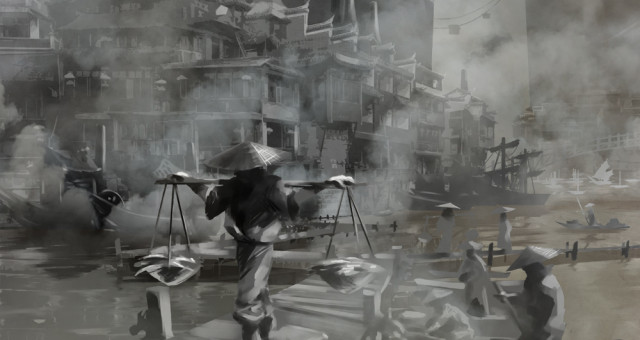
Interview: Ryan Colucci – Orient City
The moment I got a first look at Orient City: Ronin and the Princess, the beautiful hand drawn animation being created by Ryan Colucci and Zsombor Huszka, I knew I had to dig deeper. If you haven’t read my post about Orient City, it’s a samurai spaghetti western based on the combination of the American Wild West and Feudal Asia. It follows the story of Boshi, a fallen samurai, as he protects Neela from those who destroyed their lives. They head to Orient City to seek revenge against those responsible.
I was able to interview Ryan Colucci in order to dig deeper into Orient City and the process of creating it.
Interviewer: So, Orient City, when I read the premise of it, it was very interesting to me. It was described as a samurai spaghetti western that mixes the American Wild West with feudal Asia. Where did you draw your inspiration from in order to create this story? It sounds like a unique combination.
Ryan: Zsombor, who is my partner on the project (and also) the artist for my graphic novel R.E.M., he and I were actually on a book tour travelling around conventions. He came to America for a few weeks and we just hit every convention we could. And you don’t want your table to look so sparse when you have a book so we put out a lot of art prints. And he was sketching an art print of Batman as a samurai, and we both liked that. And he’s obsessed with Batman, especially like the Frank Miller Batman.
Interviewer: Nice.
Ryan: And so, he’s drawing this Batman samurai and it was coming out pretty cool and I was like, “Oh, do this,” and “do that”, and we wound up naming it the Dark Ronin and everything – It was literally from that. And in these long car rides we just started spit-balling ideas of this world that the Dark Ronin lives in. And we’re like, well we’re not going to make a Batman movie, clearly that would be insane. And that’s how Orient City kind of came about… as this samurai world that was more modern and then it was just more about how do we make this more unique. Spaghetti westerns are my favorite genre of film and Zsombor actually was on the Hungarian national fencing team so (he’s) obsessed with swords.
Interviewer: Wow.
Ryan: We have some gun play but you want to keep that ephemeral element and you want to be able to use swords, so it’s the advent of gunpowder and essentially people are carrying muskets. So you get one shot, maybe two, before someone’s in your face at close range. These aren’t six-shooters people are carrying around or anything like that, so the weapon of choice is usually a blade.
Interviewer: You described that this originated from turning Batman into a samurai, and you mentioned Frank Miller. How would you describe the tone of Orient City as a movie? Does it draw off of some of those elements of Frank Miller’s run with Batman? Or is it a combination of something else?
Ryan: It’s a combination of a bunch of stuff. It’s definitely… I mean I grew up reading Frank Miller and it’s hard for it not to shape me especially because the characters are so well fleshed. I don’t want to compare myself to Frank Miller – I hope my characters are fleshed out like his, but he always creates this dark, gritty world. Batman is already a dark character and somehow Frank Miller made it even darker – he made Gotham even darker, and that element of Frank Miller is definitely shining through. There are a lot of elements of Tarantino’s films like Kill Bill that will be there. I love the idea of creating worlds because that’s why I go to movies. I’m a child of the 80’s and the idea to create my own world is a dream come true. (Orient City) pulls a lot from the relationship between Boshi, the fallen samurai in Orient City, who when we open this (is) weeping lying in an opium den, and the little girl that he winds up hunting with has elements of Leon: the Professional, or the Denzel Washington movie Man on Fire which is another really ultra-violent movie.
Interviewer: You went the traditional route with hand-drawn animation. Was it a style that you wanted to convey that made you go with hand-drawn or was it more of a necessity? And since you started using hand-drawn animation have you noticed any benefits that you weren’t aware of before?
Ryan: To be honest with you it never was even a discussion between Zsombor and I what it was gonna be. I think we both just assumed that it would be because he was gonna be the lead animator. And he can do 3D stuff, but he is an artist. And both of us are obsessed with hand drawn animation and it just made sense from a stylistic point. I’ve made Battle for Terra which is a CG film right out of grad school and I’m really proud of it. (It was) animation studio that we built from scratch, as my first film. (But) with the CG the human characters are so lifeless. And I don’t want to speak for all of the films… things like The Incredibles are incredible; but they’re very cartoony and this is an animation for adults. I learned on Battle for Terra which walks this weird line… the aliens are very kids friendly, but it’s called Battle for Terra because of its massive third act battle where… a lot of people, and aliens die.
Interviewer: Yeah.
Ryan: And I don’t think the CG is there yet, where it’s… it’s – it’s almost too creepy, you know, I know it’s been a while since Final Fantasy, but it’s so lifeless and eerie, there’s no life in those eyes. And I see those types of movies and I felt like, “this would have so been much better as 2D hand drawn” And also it’s an art.
Interviewer: You want the style to represent the tone as well, you don’t want someone to come in expecting one movie based on for the visuals and it’s a completely different movie. So what would you say you learned since Battle For Terra that directly influenced your work on Orient City whether it was an approach or your understanding of what to do and what not to do? How did it influence this film?
Ryan: A few things. First was, make sure that you target a specific audience and that’s not to say you can’t make a film for everybody. But when you walk in (decide whether it’s a) violent movie or a movie for kids. Make the decision don’t waffle, because when you waffle or struggle with that line you fail. There’s no way to appeal to kids with something ultra-violent. People won’t just put it – even if kids want to see it – people won’t put it in front of their eyes. And also, if you’re putting children’s elements into a movie that’s violent like that the hard core fans are just gonna laugh at you because your aliens are too cuddly. That was one lesson, the other lesson was the process. Like I said I wasn’t trained in producing animation which was actually the biggest benefit my partner and I had for when we were doing that film. Because everyone kept telling us no, that we just kept saying, you know, giving them the finger essentially. And one said, you can’t do it because of animation, and they said you can’t build your animation studio on Los Angeles then they said, “you cannot make a cast for this.” And we just keep doing it. So part of it was just, buckle down and do it, you can get it done.
And the other lesson I learned, it was a tough lesson, it was I didn’t love CG animation, I loved hand drawn animation. So hand drawn animation takes a long time, and if you don’t love every second of it, then it’s not worth doing. And I’m not saying that I fell out of love with Battle for Terra, but as some of us with such human designs coming in, and things like that. It was obvious that, they didn’t live up to some of the other designs. (Another lesson learned) is the script is the most important thing. Absolutely the most important thing and I always, you know, I’m not a – a savant or something but now it’s to the point where I spend as much time on a script as humanly possible and don’t move forward until that’s locked. Especially with animation in Orient City, particularly because it’s hand drawn, you know, you can’t go back to the cutting room and find outtakes, there are no outtakes.
Interviewer: Yeah.
Ryan: So, Zsombor and I have spent a lot of time on the script and then help draw story boards. And actually, there was one version of it that started and then it evolved greatly. Like a year ago there was no little girl character and now it’s completely different today. And we found the heart of the story, and it wouldn’t have been good without her, it would have been beautiful and it would have been violent but there was no – nothing to hang your head on in terms of the character.
Interviewer: Now the opening sequence of the film that you have on your kick starter is a long shot of Orient City as you described from the lowest level to the highest level. What was the biggest challenge in creating Orient City?
Ryan: That shot itself. That shot itself is epic. It was one of those things we were able to do ourselves without any outside help. This is the best representation of what we’re doing. Yeah there’s no character in it per se but people will get a sense of the world and the scale of the world and the beauty of what we’re doing. Hopefully they can see that right from the get go.
The hardest part was the technical side of that shot of that because it was vertically. But you have to get the frame rate right or the frame or the image actually stutters. So, it took us a few – it took us a long time to figure out the exact frame rate we needed and then even then, it was still stuttering and we decided to do a section of the image as, kind of, full quality and see how it came out it and we did. And then, we added motion blur to that and then we added the elements, like there’s pollen moving across the screen and dust and clouds and that stuff hides the stutter. We stop at this cable car station and then this dock and then we push in to the saloon and it’s two totally separate moves and you’re not talking about live action, so it’s too different. You’re talking about, uh, what is essentially a computer, and how it reads pixels, doing two separate things. So, that was hard bringing those two things together in the nicest way.
Interviewer: So, were you able to use that invention from R.E.M. about half an hour a sleep every night? The four hour sleep a full day of sleep?
Ryan: I’m working on it.
Interviewer: Speaking of graphic novels, do you have any additional graphic novels in the works now or would that be after Orient City is released?
Ryan: So, I have three that are in production. One is really deep, it’s called Borderland. It’s a young adult book. Some of my favorite movies are Gremlins and ET and I love Iron Giant. My stories are dark for the most part. This is my one story that I can actually share with children. It’s about a boy who gets an egg from his dad and these two creatures hatch out of it and one turns out to be bad and one turns out to be good. And that is really deep. You know, there may be some tweaks on the coloring and then it has to be leathered. It’s 183 pages.
Zsombor and I were working on a follow up to R.E.M. called Penny Black, which is a thriller with a girl. We were also laying out the graphic novel for this thing called Chasing Rabbits which is going to be really, kind of, epic. For me one of the best things that I’ve done in terms of writing and it’s about a 250 page novel, which is pretty big for financing myself. It’s like Seven or Silence of the Lambs, but inspired by Alice in Wonderland and Through the Looking Glass.
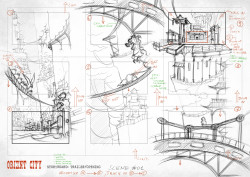


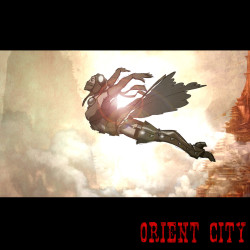
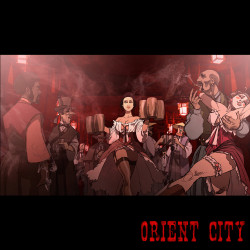
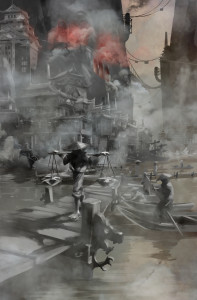
2 comments
Ryan Colucci - May 25, 2016 7:08 PM
You’re the man – thanks!
Kareem Ali - May 25, 2016 10:41 PM
Thanks Ryan